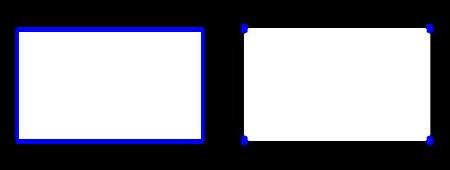 |
OpenCV
3.1.0
Open Source Computer Vision
|
 |
OpenCV
3.1.0
Open Source Computer Vision
|
Contours can be explained simply as a curve joining all the continuous points (along the boundary), having same color or intensity. The contours are a useful tool for shape analysis and object detection and recognition.
Let's see how to find contours of a binary image:
See, there are three arguments in cv2.findContours() function, first one is source image, second is contour retrieval mode, third is contour approximation method. And it outputs the contours and hierarchy. contours is a Python list of all the contours in the image. Each individual contour is a Numpy array of (x,y) coordinates of boundary points of the object.
To draw the contours, cv2.drawContours function is used. It can also be used to draw any shape provided you have its boundary points. Its first argument is source image, second argument is the contours which should be passed as a Python list, third argument is index of contours (useful when drawing individual contour. To draw all contours, pass -1) and remaining arguments are color, thickness etc.
To draw all the contours in an image:
To draw an individual contour, say 4th contour:
But most of the time, below method will be useful:
This is the third argument in cv2.findContours function. What does it denote actually?
Above, we told that contours are the boundaries of a shape with same intensity. It stores the (x,y) coordinates of the boundary of a shape. But does it store all the coordinates ? That is specified by this contour approximation method.
If you pass cv2.CHAIN_APPROX_NONE, all the boundary points are stored. But actually do we need all the points? For eg, you found the contour of a straight line. Do you need all the points on the line to represent that line? No, we need just two end points of that line. This is what cv2.CHAIN_APPROX_SIMPLE does. It removes all redundant points and compresses the contour, thereby saving memory.
Below image of a rectangle demonstrate this technique. Just draw a circle on all the coordinates in the contour array (drawn in blue color). First image shows points I got with cv2.CHAIN_APPROX_NONE (734 points) and second image shows the one with cv2.CHAIN_APPROX_SIMPLE (only 4 points). See, how much memory it saves!!!

 1.8.9.1
1.8.9.1